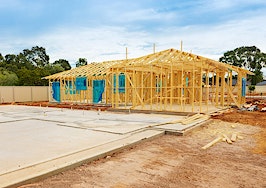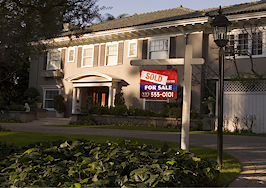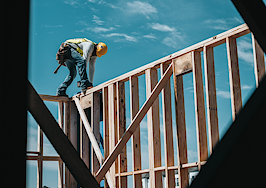The Inventory Inquiry is a weeklong Inman series analyzing the ongoing housing shortage. We’re digging into the state of the construction industry, the listing void that startups are vying to fill and the own-to-rent boom causing inventory schisms nationwide, among other big issues. Check back for more on the inventory imbroglio, all week long.
Just like the partly cloudy skies that shrouded Lennar’s Miami headquarters during its first-quarter earnings call in March, the company’s leadership offered an equally mixed forecast of what lay ahead for the homebuilding industry in 2022.
For Lennar Executive Chairman Stuart Miller, the sunny spot was an abnormally robust homebuying market buoyed by record-low mortgage rates and a gargantuan shift in homebuyer needs due to the coronavirus pandemic.
“Our core operating performance in the first quarter reflects the continued strength in the housing market across the country,” he said. “Our sales pace remained strong and consistent throughout the quarter, while strong traffic to our welcome home centers and website suggests that demand remains strong for the foreseeable future.”
Although Miller and his associates attempted to focus on the bright side, they couldn’t ignore the growing storm clouds threatening their ability to fight supply chain issues that slowed their quarterly production cycle by two weeks for two consecutive quarters.
“While demand is strong, supply is short and constrained,” Miller admitted. “The ability to actually build and deliver homes has been slowed by the supply chain that is all but broken, by the workforce that is short in supply, and the intense competition for scarce entitled land assets. Therefore the supply of homes has remained quite limited and is not prone to overbuilding.”
Lennar’s competitors — Texas-based builder D.R. Horton and Georgia-based PulteGroup — delivered similar earnings reports that acknowledged the challenge of skyrocketing lumber costs, weakened labor forces and issues sourcing building materials and appliances.
Those issues, they said, will continue to plague the homebuilding industry as buyers crack under the weight of skyrocketing home prices that can only be cooled by one of two things: an astronomical increase in supply or a disheartening decrease in demand.
“Just about every housing analyst and housing economist right now agrees that we need to add more housing, and it’s not just single family housing — we need to build more townhouses, more missing middle duplex type housing, and more apartments,” National Association of Home Builders Chief Economist Robert Dietz told Inman. “There’s no single scalable solution that’s going to solve the problem. It’s going to require years to fix the problem, and buyers will be priced out in the process.”
The Great Recession never ended for builders
Although plenty of homebuilders are blaming their current woes on supply chain and labor issues, Dietz said the root of the inventory problem reaches back to the Great Recession. In the years leading up to the housing crash, homebuilders grossly overbuilt homes in much of the country resulting in a record-high residential vacancy rate of 13.4 percent two years before the bubble finally burst.
“The origin of a lot of these issues is the legacy from the Great Recession itself, which led to a really dramatic decline in home production,” he told Inman. “There was overbuilding in the years leading into the recession, and then you get a dramatic drop in actual home construction activity as that surplus back then had to be worked down.”
“The result was that about half of private homebuilders in the country went out of business,” he said. “You had about a third of the industry’s workforce leave the industry.”
Dietz said the efforts to correct the lending system and stop banks from providing unqualified borrowers with subprime loans not only impacted homebuyers but also smaller private homebuilders who often relied on community bank loans to fund projects.
“With all of that combined, then banks became a little more risk-averse when it came to lending into real residential construction development purposes,” he added while noting 60 percent of the nation’s housing stock is produced by privately owned builders.
Beyond a mass workforce exodus and tougher lending standards, Dietz said the recession also ushered in more stringent zoning laws that slowed homebuilders’ production time as they attempted to navigate complicated permit qualifications.
In the years leading up to the pandemic, legislators across the nation lobbied for looser zoning laws that would enable homebuilders to build duplexes, triplexes, and other multi-family housing structures on land once reserved for single-family dwellings, but most of their efforts to boost supply have failed.
“For a typical single-family home, about a quarter of the price is made up of various kinds of burdens that come about from government policy, and that includes delays getting permits approved and developing land,” he explained. “Sometimes zoning laws require a certain amount of land to be unbuilt on, which then increases the cost of all the homes that you actually can build.”
“Building code requirements that are beyond what the market requires, inefficient zoning [laws] like minimum lot sizes and a whole series of things such as fees and taxes associated with home construction have made it worse,” Dietz added. “If you add all those together, it’s left the country with a housing deficit of at least a million homes.”
In addition to crushing the homebuilding industry, Realtor.com Senior Economist George Ratiu said the recession accelerated the downfall of the United States’ manufacturing capacity as companies shuttered their stateside factories and increasingly began looking to other countries to provide labor and materials.
Although outsourcing led to higher profits in the short term, Ratiu said it also means American homebuilders are beholden to the economic ebbs and flows of another country. “We’ve had almost 30 years of globalization where we’ve outsourced more and more of the various components we need to build a home, from wood to nails and bolts to appliances,” he said. “But the pandemic exposed the dangers of that model, and we’re also seeing the added impact of the Ukraine war.”
“If any one of those chains actually falters or breaks, as it has now, it leads to much bigger issues,” he added.
The added weight of the coronavirus pandemic
Dietz, Ratiu and Redfin Deputy Chief Economist Taylor Marr said the pandemic has exacerbated the inventory shortage as homebuyers snap up homes quicker than sellers can list them and builders can construct them. According to the U.S. Census Bureau’s latest monthly report, homebuyers are increasingly turning their attention to unfinished new homes as their last chance to take advantage of mortgage rates before they eclipse 5 percent.
“New homes sold in February at a seasonally adjusted annual rate of 772,000, a 2 percent decline from the previous month and 6 percent lower than the same time last year,” a previous Inman article explained. “This decline was driven by a 9 percent monthly drop in the number of homes sold that were currently being built. At the same time, sales of the smaller group of homes that have not yet begun construction rose by 9 percent from January to February.”
The abnormally strong homebuying market is pushing homebuilders to streamline their offerings, like Lennar’s “Everything’s Included” package that reduces the number of choices homebuyers need to make to complete their home. Homebuilders are also only listing homes once they’ve neared completion, like Texas-based builder D.R. Horton. Although they’re staying afloat for now, NAHB Chairman Jerry Konter said homebuilders need relief soon.
“While builders continue to report solid buyer traffic numbers, helped by historically low existing home inventory and a persistent housing deficit, increasing development and construction costs have taken a toll on builder confidence,” Konter said of the fourth consecutive decline in monthly homebuilder sentiment, which in March reached its lowest point since September 2021. “Improving access to lumber, OSB and other materials will help builders increase the supply of badly-needed housing and fight inflation.”
Marr said inflated lumber costs and supply chain issues have increased the cost of building a home by 22 percent over the past year alone. “Lumber prices are about three times their cost pre-Covid and can add between $18,000 and $30,000 to a new single-family home,” he noted in an emailed statement to Inman.
All three economists said the price of lumber will continue its rapid ascent as the Biden administration doubles down on the previous administration’s decision to place higher tariffs on Canadian softwood. In late November, Biden announced the tariff would increase from 9 percent to 17.9 percent due to “antidumping and countervailing duties” rather than “crude protectionism.”
No matter the validity of Biden’s rationale, all three men said the decision to raise tariffs will continue to punch homebuilders and homebuyers in the gut harder and harder until the administration decides to reverse its decision.
“Lumber prices are way up. Oriented strand board is a type of particle board that’s used in home construction and its pricing is up 500 percent due to the COVID situation,” Dietz said. “For structural lumber, we have tariffs of [17.9 percent] and we don’t produce enough lumber here in the United States to offset that.”
“Economic theory says that if you don’t produce enough, you should trade and we just happen to be neighbors with a country that produces a lot of lumber,” he added. “But when you put tariffs on, that increases the price of lumber and it increases inflation and about a third of inflation is due to rent and housing costs.”
Ratiu said the cost of lumber and other homebuilding essentials are unlikely to reverse anytime soon as European nations from whom we source much of our wood fight the coronavirus and the threat of a multinational war with Russia as they attack Ukraine.
“We source a lot of lumber from European countries,” he said. “For other parts of the construction process, obviously during the pandemic a lot of those countries we rely on had their own quarantines. Most people wouldn’t think about glue, nails, screws, components for washing machines, dishwashers, stoves, a lot of these come from partners all over the world.”
Lastly, Dietz said inflation, which reached a 40-year high of 7.9 percent in February, is making it harder for privately owned homebuilders to secure the loans needed to withstand higher material costs and the financial risk that comes with increasing completion timelines.
“Higher interest rates also make it more expensive to borrow money on the business side, in terms of land development and construction activity,” he said. “It’s taking longer to build housing. Before COVID, it was about six and a half months to build a single-family home. Today, it’s probably closer to eight months.”
Zoning, Home Depot and domestic production: What it will take to fix homebuilding in the US
As the spring homebuying season goes into full swing, market analysts have already dashed homebuyers and real estate agents’ hopes of a boost in inventory.
“There were roughly 730,000 homes for sale nationwide in February, compared to 1.4 million in February 2020,” Zillow noted in its latest market report published on March 17. “Historically, inventory has generally bottomed out in December and then rebounded as sellers listed their homes in preparation for the busy spring shopping season, but this year, supply has continued to dwindle well into the new year and inventory was 11.9 percent lower in February than in January.”
Although some homebuyers are deciding to hold out for another year or two in hopes of a more balanced market, Dietz, Ratiu and Marr said it will take up to another decade to fix the deep-seated issues keeping homebuilders from closing the inventory gap.
“It’s gonna require years to fix everything because ultimately, we’ve got to address all the issues that are responsible for the lack of home construction,” Dietz said. “We need to get up to about 1.2 million single-family homes built a year to begin reducing the housing deficit.”
He added, “Even if we’re building 1.2-1.3 million single-family homes a year, that might reduce the housing deficit by 100,000 units in that year. So at that pace, it would take about 10 years to really catch up.”
Even if homebuilders are able to ramp up production and slow home price growth through added inventory, Dietz said homebuyers shouldn’t expect to see a dramatic decrease in the cost of a home.
“You can expect at some point an easing up of the growth rate, but that doesn’t mean that you’ll see a decline in the cost of building materials or homes,” he said. “The growth rate of home prices, I like to think, is going to slow here in 2022. The Case Shiller Index has been up 15 to 20 percent year over year and that’s unlikely to continue in an environment with higher interest rates.”
“But housing prices will ultimately be high as long as there’s a housing deficit,” he added.
Dietz said many of the solutions needed to help homebuilders close the gap will take years to enact, such as pushing local governments to adopt streamlined permitting practices and enabling homebuilders to diversify their projects through upzoning, which allows builders to construct multi-unit housing on land once zoned for single-family homes. He also said existing homeowners’ aversion to affordable housing models, also known as the “Not In My Backyard” (NIMBY) movement, isn’t helping.
“The ongoing trend [of tighter lending standards] and other rules that make [building] more expensive on the regulatory side, and a step up in NIMBY-ism, all create what Federal Reserve Chairman Jerome Powell a few years ago referred to as a perfect storm for homebuilders,” he said. “And, as I said before, the consequence of that is a fairly substantial housing deficit.”
Although the most substantial fixes are long-term, Marr and Ratiu said there are a few things the government and the homebuilding industry can do to help boost inventory and cool home price growth now.
“The Biden administration should remove the tariffs on Canadian lumber,” Marr said while noting that measure alone could cut five figures from the price of a new home. “There also are additional labor and educational policies to encourage more construction workers, but all of these things are an indirect way to remove additional challenges builders are facing beyond the immediate supply chain challenges as overseas shipping hits bottlenecks.”
Meanwhile, Ratiu said homebuilders can streamline their material sourcing process by relying on fewer companies to provide goods and begin relying on U.S.-based manufacturers for certain items. “You have so many different distributors, subcontractors and suppliers that it’s hard to coordinate, so being able to go to a company that provides all of these things in bulk can help streamline the process,” he said.
“The other thing, and I think this is worth mentioning, [is] some of the big box stores like Lowe’s and Home Depot. We actually saw builders that resort to these big box stores during this pandemic, when their suppliers couldn’t meet the need for appliances,” he added. “So I think the reason I’m bringing this up is not necessarily to highlight big box stores. But I think there is potentially a role that big box stores can play because they get preferred treatment simply based on the volume they purchase from manufacturers.”
As homebuilders attempt to unravel a decade’s worth of issues, Ratiu said there’s still a sliver of hope for homebuyers who can’t wait for builders to close the inventory gap.
“We surveyed homeowners and 26 percent said they are planning to list their home in the next 12 months,” he said. “In our February data, we saw about 13 out of the 50 largest cities in the country with price declines and it wasn’t the first month of price declines for some of those cities — it was the fifth month of price declines.”
“A more normal market is on the horizon,” he added.













